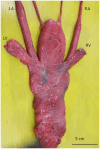Case Report: Reproductive evaluation of a Murgese stallion with obstructive azoospermia, accumulation of hyaline material in the ampullae ducts, and corpora amylacea in vesicular glands
- PMID: 40290475
- PMCID: PMC12021803
- DOI: 10.3389/fvets.2025.1571637
Case Report: Reproductive evaluation of a Murgese stallion with obstructive azoospermia, accumulation of hyaline material in the ampullae ducts, and corpora amylacea in vesicular glands
Abstract
This report aims to present a case of obstructive azoospermia in a stud stallion diagnosed with an alkaline phosphatase (SPAP) assessment. A 20-year-old Murgese stallion is referred for acquired azoospermia. History is negative for reproductive disorders, and clinical examinations and ultrasonography of internal and external genitalia do not reveal significant alterations. Semen collection highlights the absence of spermatozoa in the ejaculate and the urinalysis is negative for spermatozoa. SPAP assay is performed on seminal plasma, with a value of 30 IU/L, compatible with obstructive azoospermia. A biopsy is performed, detecting the presence of complete germ lines in both testes. A resolution is attempted endoscopically, gently insufflating ampullae, with negative results, so the stallion is excluded from breeding. Time afterwards, the stallion dies of natural causes, and necropsy and histopathological analyses are performed. Corpora amylacea are highlighted in both seminal vesicles; the right and left ampullae show ectasic lumen, with the diffuse presence of hyaline material. Ampullae obstruction is an uncommon pathology, which can affect stallions and jacks, generally caused by the accumulation of spermatozoa, but, unfortunately, this case was unresponsive to attempted treatments. Interestingly, to the authors' knowledge, this is the first report of corpora amylacea in equine stallion sexual glands.
Keywords: alkaline phosphatase; breeding soundness evaluation; corpora amylacea; endoscopy; equine andrology; obstructive azoospermia.
Copyright © 2025 Bucci, Parrillo, Probo, Varasano, Romano and Carluccio.
Conflict of interest statement
The authors declare that the research was conducted in the absence of any commercial or financial relationships that could be construed as a potential conflict of interest.
Figures



Similar articles
-
Alkaline phosphatase in stallion semen: characterization and clinical applications.Theriogenology. 2003 Jun;60(1):1-10. doi: 10.1016/s0093-691x(02)00956-1. Theriogenology. 2003. PMID: 12620574
-
Azoospermia in stallions: determining the cause.Compend Contin Educ Vet. 2012 Feb;34(2):E2. Compend Contin Educ Vet. 2012. PMID: 22488664 Review.
-
Azoospermia and Y Chromosome-Autosome Translocation in a Friesian Stallion.J Equine Vet Sci. 2019 Nov;82:102781. doi: 10.1016/j.jevs.2019.07.002. Epub 2019 Jul 11. J Equine Vet Sci. 2019. PMID: 31732110
-
Equine sperm-bound antisperm antibodies are associated with poor semen quality.Theriogenology. 2018 Sep 15;118:212-218. doi: 10.1016/j.theriogenology.2018.05.034. Epub 2018 Jun 1. Theriogenology. 2018. PMID: 29935460
-
Freezing Stallion Semen-What Do We Need to Focus on for the Future?Vet Sci. 2024 Feb 2;11(2):65. doi: 10.3390/vetsci11020065. Vet Sci. 2024. PMID: 38393083 Free PMC article. Review.
References
-
- Kenney RM. Clinical fertility evaluation of the stallion. Ann Meet Am Assoc Equine Practiti. (1976):336–55.
-
- Purswell BJ, Althouse GC, Root Kustritz MV, Pretzer S, Lopate C. Guidelines for using the canine breeding soundness evaluation form. Theriogenol Handbook. (1992) 51–59. SA-C1 (8/92)
Publication types
LinkOut - more resources
Full Text Sources

